![]()
![]()
![]()
Use LEFT and RIGHT arrow keys to navigate between flashcards;
Use UP and DOWN arrow keys to flip the card;
H to show hint;
A reads text to speech;
66 Cards in this Set
- Front
- Back
|
Cutaneous nerve distribution of the face |
Sensory Innervation of the face is provided by the divisions of the trigeminal nerve (CN V). Ophthalmic nerve (V1), Maxillary (V2), Mandibular (V3) |
|
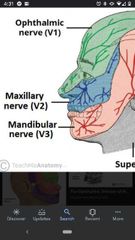
Ophthalmic division (V1) |
Innervates the skin of the forehead, upper eyelids, & nose. |
|
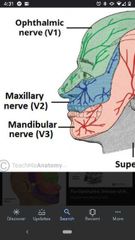
Maxillary division (V2) |
Innervates the skin of the lower eyelid, cheek, and upper lip. |
|

Mandibular division (V3) |
Innervates the skin of lower face and part of the side of the head. |
|
|
Cervical spinal nerves 2 & 3 |
Innervate the skin of the posterior part of the head. |
|

Frontal bone |
Superior to the orbit, forms the forehead and the roof of the orbit. |
|
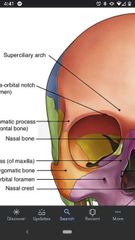
Superciliary arch |
A thickened ridge along the superior margin of the orbit. |
|
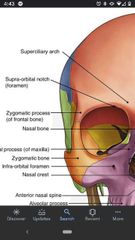
Supraorbital notch |
Contained within the right & left superciliary arches and separated by the glabella. |
|
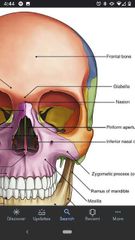
Glabella |
Separate the right & left superciliary arches of the frontal bone. |
|

Nasion |
Inferior to the glabella, the junction between the frontal and nasal bones. |
|
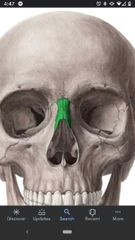
Nasal bones |
Right and left nasal bones form the superior extent of the bridge of the nose. |
|
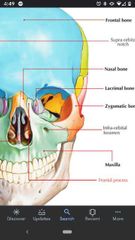
Frontal process of maxilla |
Posterior to the nasal bones, extending superiorly to the frontal bone. |
|
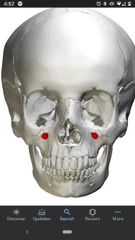
Infraorbital foramen |
Opening on the anterior surface of the maxilla. |
|
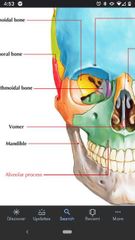
Alveolar processes |
The thickened ridges corresponding to the attachment sites for the upper dentition. |
|
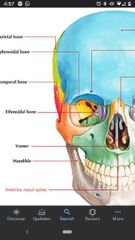
Anterior nasal spine |
In the midline, a small bony projection, oriented anterior and interior to the nasal septum. |
|
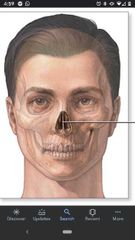
Nasal septum |
Superior to the nasal spine. |
|
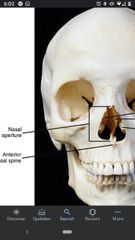
Anterior nasal aperture |
Bounded by the nasal bones & maxillae. |
|
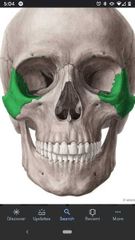
Zygomatic bones |
Lateral to the maxillae, near the region of the cheek. |
|
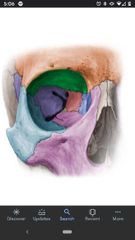
Orbital margin |
Formed by 3 bones: frontal, Maxillary, & zygomatic bones |
|
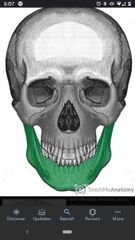
Mandible |
Jaw |
|
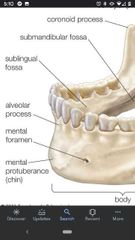
Alveolar process of mandible |
Attachment sites for the lower dentition. |
|
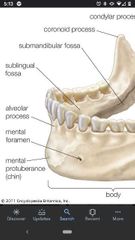
Mental protuberance |
Midline of the mandible, a thickened ridge marking the fusion point of the right and left mandible during development. |
|
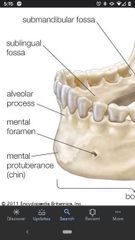
Mental foramen |
On the anterior surface of the mandible, the bilateral openings. |
|
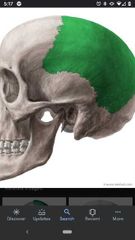
Parietal bones |
Paired bones posterior to the frontal bone. |
|
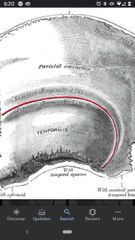
Superior/inferior temporal Iines |
On the parietal bones, demarcate the superior attachment of the temporalis muscle. |
|
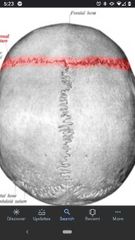
Coronal suture |
Where the parietal bones articulate anteriorly with the frontal bone. |
|

Lambdoid suture |
Where the parietal bones articulate posteriorly with the occipital bone. |
|
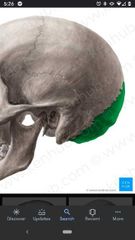
Occipital bone |
The posterior aspect of the skull. |
|
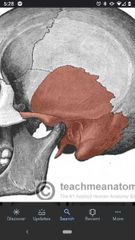
Temporal bone |
On the lateral aspect of the skull. |
|
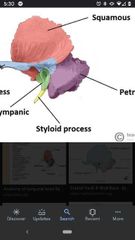
Squamous part |
The flat part of the temporal bone. |
|

Squamosal suture |
Where the temporal bone meets the parietal bone. |
|
|
Petrous part of temporal bone |
The "rock-like" portion of the temporal bone that extends into the cranial cavity. |
|
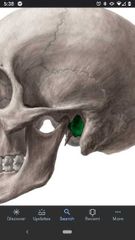
External acoustic meatus |
On the lateral aspect of the temporal bone, an opening anterior to the mastoid process. |
|

Zygomatic process |
Part of the temporal bone that extends toward the zygomatic bone. |
|
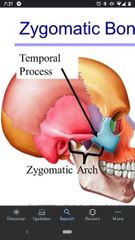
Temporal process of zygomatic bone |
Zygomatic process of temporal bone meets this process. |
|

Zygomatic arch |
The zygomatic process of temporal bone and temporal process of zygomatic bone form this structure. |
|
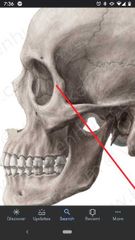
Frontal process of zygomatic bone |
Vertically oriented, articulates with frontal bone lateral to orbital margin. |
|
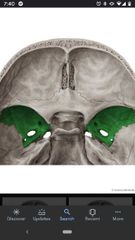
Greater wing of sphenoid bone |
A depression in the "temple", lateral side of head, anterior to temporal bone. |
|
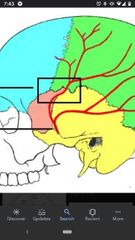
Pterion |
Superior to the greater wing of the sphenoid. The junction of the frontal bone, parietal bone, greater wing of sphenoid, & squamous part of temporal bone. |
|
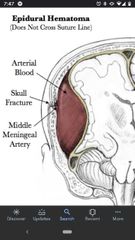
What is the clinical importance of this area? |
It's a common site of fracture; the middle meningeal arteries are located here. They can rupture and cause an epidural hematoma (internal bleeding between the skull and the dura mater. More serious than a subdural hematoma. |
|
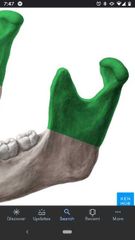
Ramus of mandible |
The vertical portion. |
|
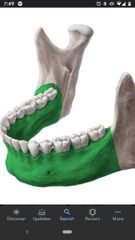
Body of mandible |
The horizontal portion. |
|

Angle of mandible |
The angular portion between the ramus and body of mandible. |
|
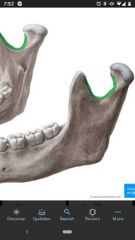
Mandibular notch |
Where the mandible splits superiorly into two processes. |
|
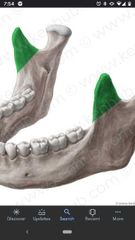
Coronoid process of mandible |
The anterior process of the ramus of the mandible. |
|
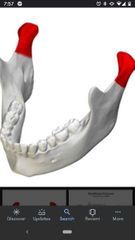
Condyloid process |
The posterior process of the ramus of the mandible. The head of mandible serves as the articulation for temporalmandibular joint (TMJ), the only movable joint in the adult skull. |
|
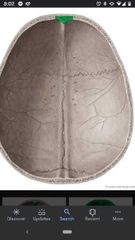
Calvaria |
"skull cap", formed by parts of the frontal, parietal, and occipital bones connected through sutures. |
|
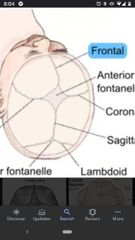
Frontal (metopic) sutures. |
Forms between the ossification centers of the paired frontal bones, usually not seen in th adult. |
|
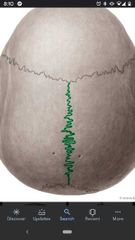
Sagittal suture |
Lies between the two parietal bones. |
|
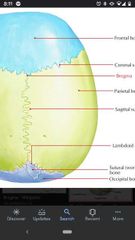
Bregma |
The point where the coronal and sagittal sutures meet. |
|
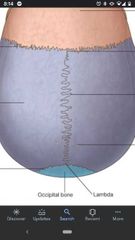
Lambda |
The point where the sagittal and lambdoid sutures meet. |
|
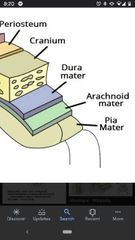
What are the 3 membranes of the brain? |
The 3 meninges are called dura mater, arachnoid mater, & pia mater. |
|
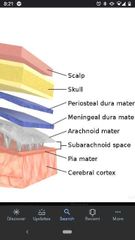
What are the 2 layers of the dura mater? |
Periosteal layer & internal meningeal layer. Where they separate they enclose the dural venous sinuses and form the falx cerebri and falx cerebelli. |
|
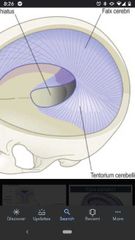
Falx cerebri |
Formed by the layers of the dura mater. Divides the brain into the right & left hemispheres. Attaches to Crista galli |
|

Falx cerebelli |
Small fold of dura mater over the floor of the posterior cranial fossa. |
|
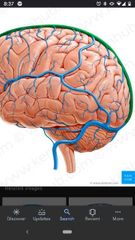
Superior sagittal sinus |
A dural venous sinus coursing along the superior extent of the cranial cavity in the midline. Drains into the confluence of sinuses. |
|
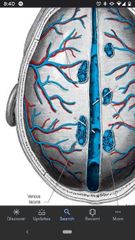
Lateral venous lacunae |
Along the wall of the sinus, contain arachnoid granulations. |
|
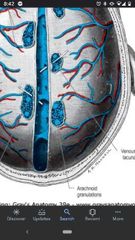
Arachnoid granulations |
Within the lateral venous lacunae, responsible for the return of CSF to the venous system. |
|
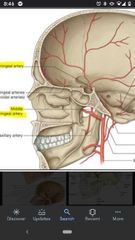
Middle meningeal artery |
Supplies the dura mater and adjacent calvaria. The anterior branch crosses the inner surface of the pterion, where it may tunnel through the bone. |
|
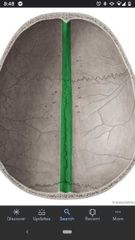
Groove of the superior sagittal sinus |
The Inner surface of the calvaria at the bottom. |
|
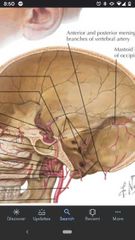
Grooves the branches of the middle meningeal artery. |
The inner surface of the calvaria. |
|
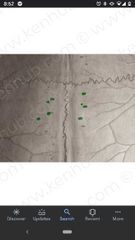
Granular foveolae |
Shallow depressions that are present on the inner surface of the calvaria. Formed by the arachnoid granulations. |
|
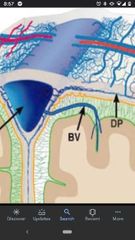
Bridging veins |
They connect the superior cerebral veins to the superior sagittal sinus. |
|

Cerebral veins |
Visible through the arachnoid mater, drain into the superior sagittal sinus via bridging veins. |
|
|
Epidural hematoma |
Fractures through the pterion, may result in tearing of the middle meningeal artery causing an epidural hemorrhage. Blood accumulates between the skull and dura mater, resulting in life threatening compression of the brain. |
|
|
Subdural Hematoma |
At the point where the bridging veins enter the superior sagittal sinus, they may be torn in cases of head trauma. The bridging veins may bleed into the potential space between the dura and arachnoid mater, blood accumulates here. |

